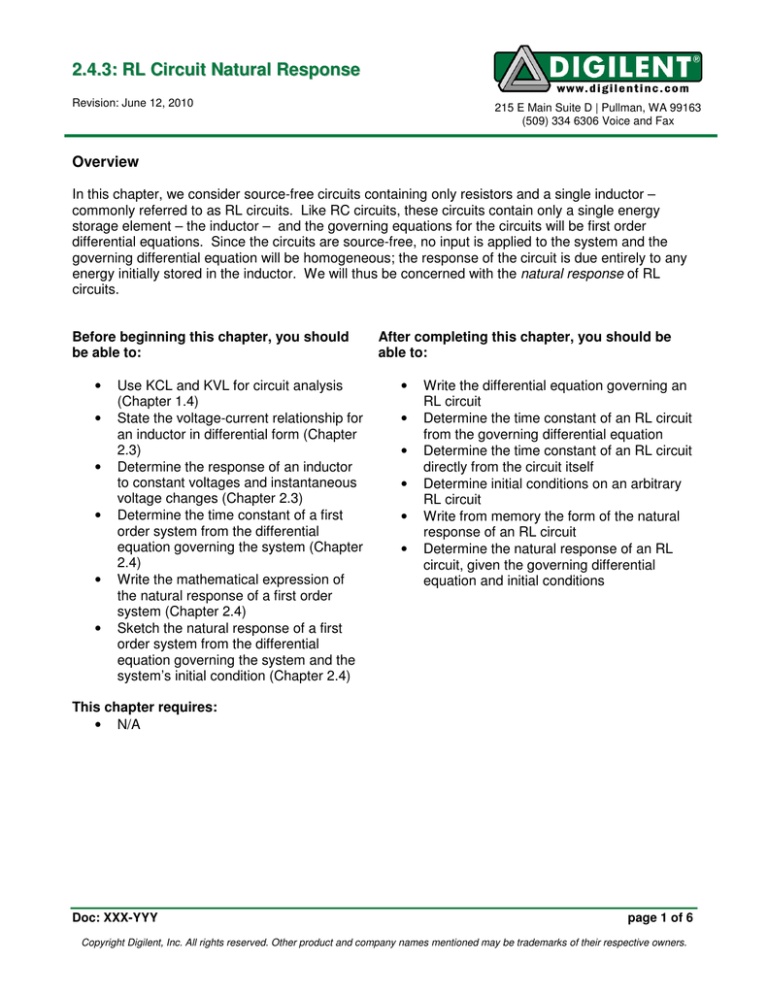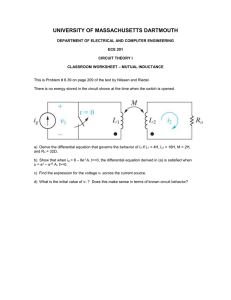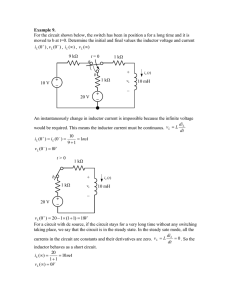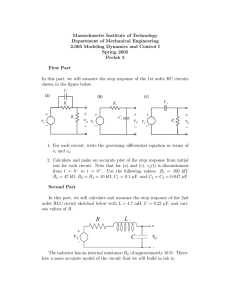
2.4.3: RL Circuit Natural Response
Revision: June 12, 2010
215 E Main Suite D | Pullman, WA 99163
(509) 334 6306 Voice and Fax
Overview
In this chapter, we consider source-free circuits containing only resistors and a single inductor –
commonly referred to as RL circuits. Like RC circuits, these circuits contain only a single energy
storage element – the inductor – and the governing equations for the circuits will be first order
differential equations. Since the circuits are source-free, no input is applied to the system and the
governing differential equation will be homogeneous; the response of the circuit is due entirely to any
energy initially stored in the inductor. We will thus be concerned with the natural response of RL
circuits.
Before beginning this chapter, you should
be able to:
•
•
•
•
•
•
Use KCL and KVL for circuit analysis
(Chapter 1.4)
State the voltage-current relationship for
an inductor in differential form (Chapter
2.3)
Determine the response of an inductor
to constant voltages and instantaneous
voltage changes (Chapter 2.3)
Determine the time constant of a first
order system from the differential
equation governing the system (Chapter
2.4)
Write the mathematical expression of
the natural response of a first order
system (Chapter 2.4)
Sketch the natural response of a first
order system from the differential
equation governing the system and the
system’s initial condition (Chapter 2.4)
After completing this chapter, you should be
able to:
•
•
•
•
•
•
Write the differential equation governing an
RL circuit
Determine the time constant of an RL circuit
from the governing differential equation
Determine the time constant of an RL circuit
directly from the circuit itself
Determine initial conditions on an arbitrary
RL circuit
Write from memory the form of the natural
response of an RL circuit
Determine the natural response of an RL
circuit, given the governing differential
equation and initial conditions
This chapter requires:
• N/A
Doc: XXX-YYY
page 1 of 6
Copyright Digilent, Inc. All rights reserved. Other product and company names mentioned may be trademarks of their respective owners.
2.4.3: RL Circuit Natural Response
We will base our discussion of RL circuit natural responses on the series resistor-inductor circuit
shown in Figure 1. We assume that the inductor has some initial current, I0, flowing through it at time t
= 0 (so that i(0) = I0). We will determine the inductor current, i(t), for t>0.
Figure 1. RL circuit with initial condition i(t=0) = I0.
Since the inductor’s voltage drop and current are related by v( t ) = L
di( t )
, application of Kirchoff’s
dt
voltage law around the single loop in the circuit results in:
L
di( t )
+ Ri( t ) = 0
dt
(1)
In this chapter, we will solve this differential equation using the “alternate approach” presented in
chapter 2.4.2 for capacitors. This approach consists of assuming a form of the solution, based on the
form of the differential equation being solved. The assumed solution will contain unknown constants;
these constants will be determined by plugging the assumed solution into the original differential and
forcing the solution to satisfy the original differential equation and initial conditions. Since the
differential equation is linear and has constant coefficients, the solution to the differential equation is
unique – thus, if we can find any solution, we have found the only solution. This approach is an
extremely common differential equation solution method, we will use it regularly in subsequent
chapters.
The form of equation (1) indicates that i(t) must be a function which does not change form when it is
differentiated ( L
di( t )
must cancel out Ri( t ) ). The only function with this property is an exponential
dt
function. Thus, we assume that the current is of the form
i( t ) = Ke − st
(2)
where K and s are unknown constants. Substituting equation (2) into equation (1) results in
(
) (
)
L − Kse − st + R Ke − st = 0
The above simplifies to:
(R − Ls )Ke − st
www.digilentinc.com
=0
page 2 of 6
Copyright Digilent, Inc. All rights reserved. Other product and company names mentioned may be trademarks of their respective owners.
2.4.3: RL Circuit Natural Response
Which is satisfied if s =
R
or Ke − st = 0 . Choosing Ke − st = 0 results in the trivial solution i(t) = 0,
L
which will not, in general, satisfy the initial condition on the circuit. By the process of elimination, we
choose s =
R
and the form of our solution becomes:
L
i( t ) = Ke
− tR
L
(3)
The unknown constant K is determined by applying the initial condition, i(0) = I0. Evaluating equation
(3) at time t = 0, and equating the result to the given initial condition, we obtain:
i( 0 ) = Ke
− 0⋅ R
L
= K = I0
Thus, K = I0, and the solution to the differential equation is:
i( t ) = I 0 e
− tR
L
= I 0e
−t
τ
(4)
and the circuit time constant is
τ=
L
R
(5)
Equation (5) indicates that increasing L or decreasing R causes the time constant to increase.
Conversely, decreasing L or increasing R decreases the time constant. A plot of the response of
equation (4) is shown in Figure 2.
τ=
L
R
Figure 2. RL circuit natural response.
www.digilentinc.com
page 3 of 6
Copyright Digilent, Inc. All rights reserved. Other product and company names mentioned may be trademarks of their respective owners.
2.4.3: RL Circuit Natural Response
Generalization to multiple resistors:
As with the RC circuit, the resistance in the time constant of equation (5) can be more generally
defined as the equivalent overall resistance of the circuit as seen by the inductor. Thus, if we remove
the inductor from the circuit and create a Thevenin equivalent resistance as seen by the inductor, the
time constant will be the quotient of the inductance and the equivalent resistance.
Determining initial conditions:
Though the initial condition is given in the above example, in general we will need to determine the
initial condition from the application of some source and/or switching condition. For example, the
circuit of Figure 3 can be used to generate the initial condition of the example circuit above. In the
circuit of Figure 3, we assume that the switch has been closed for a long time and all circuit voltages
and currents have become constant. When all circuit operating conditions are constant, the inductor
behaves like a short circuit and all the current applied by the current source goes through the inductor
and the inductor current is I0. Since the current through an inductor cannot change suddenly, the
inductor still has current I0 immediately after the switch opens. Mathematically, i(t=0-) = i(t=0+) = I0.
where time t=0- is an infinitesimal time before the switch opens, and the time t=0+ is an infinitesimal
time after the circuit opens. Thus, for times t > 0, the shaded portion of the circuit of Figure 3 is
identical to the circuit of Figure 1 from the viewpoint of the capacitor voltage.
Figure 3. Circuit to realize the initial condition of the circuit of Figure 1.
An example is provided below to illustrate the points made in this chapter.
www.digilentinc.com
page 4 of 6
Copyright Digilent, Inc. All rights reserved. Other product and company names mentioned may be trademarks of their respective owners.
2.4.3: RL Circuit Natural Response
Example: Switched RL circuit natural response
Consider the circuit shown below. The switch has been closed for a long time; at time t = 0
seconds, the switch suddenly opens. Determine the inductor current, i(t) for t > 0.
t=0
5 mH
50 V
i(t)
+
-
25
Since we are told that the switch has been closed for a long time, we assume that all voltages and
currents in the circuit are constant before we open the switch. Therefore, before the switch is
open the inductor behaves like a short circuit and the inductor current at time t = 0- can be
determined by analyzing the circuit below:
From the above circuit, the inductor current just before the switch is opened is, from Ohm’s law,
50V
= 2 A . Since an inductor cannot change its current suddenly, the current
25Ω
immediately after the circuit opens is i( 0 + ) = i( 0 − ) = 2 A . This provides our initial condition on
i( 0 − ) =
the inductor current.
The time constant of the circuit is determined from the inductance and the equivalent resistance of
the circuit seen by the inductor, after the switch opens. The equivalent resistance can be
determined by analyzing the circuit shown below.
www.digilentinc.com
page 5 of 6
Copyright Digilent, Inc. All rights reserved. Other product and company names mentioned may be trademarks of their respective owners.
2.4.3: RL Circuit Natural Response
From the circuit above it can be seen that, to the inductor, the 25Ω and 75Ω resistors are in series.
Thus, Req = 25Ω + 75Ω = 100Ω . The system time constant is, therefore,
τ=
L
5 × 10 −3 H
=
= 5 × 10 −5 seconds.
Req
100Ω
Substitution of the initial condition and time constant into equation (4) gives
i( t ) = 2e
− t
5×10 − 5
= 2e − 20 ,000t A
Summary:
•
The natural response of an RL circuit describes the inductor current in a circuit consisting
only of resistors and a single equivalent inductance. The circuit is source-free; the
response is entirely due to energy initially stored in the inductor.
•
The RL circuit natural response is of the form:
i( t ) = I 0 e
−t
τ
, for t ≥ 0
where I0 is the initial voltage across the capacitor and τ is the circuit time constant.
•
The time constant for an RC circuit is
τ=
L
Req
where Req is the equivalent resistance “seen” by the inductor and L is the equivalent
inductance in the circuit.
•
The inductor properties:
i. Inductors behave like short-circuits when all circuit parameters are constant,
and
ii. Inductors currents cannot change instantaneously
can be useful in determining initial conditions for an RL circuit
www.digilentinc.com
page 6 of 6
Copyright Digilent, Inc. All rights reserved. Other product and company names mentioned may be trademarks of their respective owners.




